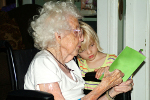A Look at the Common Types of Senior Arthritis
Published by Steve Hedberg on February 28, 2010 Under arthritis
 As the baby boomers grow older, the aging population will dramatically increase, with many of these people suffering from arthritis and other conditions that make it difficult to get around. While arthritis is not actually a single disease and can actually affect people of all ages, even children, it is far more common among the elderly. This is why arthritis is often thought of as an elderly diseases.
As the baby boomers grow older, the aging population will dramatically increase, with many of these people suffering from arthritis and other conditions that make it difficult to get around. While arthritis is not actually a single disease and can actually affect people of all ages, even children, it is far more common among the elderly. This is why arthritis is often thought of as an elderly diseases.
Of the more than 100 different types of arthritis, rheumatoid arthritis and osteoarthritis are the two most common types among those over the age of sixty-five. While these two kinds of arthritis are in many ways similar, the way they affect the body differs.
Senior Osteoarthritis
For example, osteoarthritis, which is more common that Rheumatoid Arthritis, often affects the smaller joints of the hand and usually affects the joints asymmetrically. This means that it is most common for osteoarthritis to only affect the joints on one side of the body, without affecting the joints on the corresponding side. So, for example, in someone with osteoarthritis in a load bearing joint, like the knee, it would be less common for both knees to be affected by the disease.
In osteoarthritis it is common to experience pain and stiffness in the morning or after sitting still for an extended period of time. This pain usually subsides within about thirty minutes, with it often occurring both in the morning and again in the evening. High impact sports, such as running and soccer, can also cause joint pain in those who have osteoarthritis.
In many instances, osteoarthritis also causes inflammation around the joints and bone growths. Ultimately, those with osteoarthritis will usually see a reduction in mobility.
Senior Rheumatoid Arthritis
Rheumatoid Arthritis also often affects load bearing joints, but unlike osteoarthritis, rheumatoid arthritis typically acts symmetrically.
So, when one knee is affected by rheumatoid arthritis, the other will almost always also be affected. The exact causes of Rheumatoid Arthritis are not known, but it is considered to be an autoimmune disorder, which is where the body’s defense mechanisms begin attacking healthy cells.
Joint pain is caused by rheumatoid arthritis, but unlike osteoarthritis, the joint pain will often last for over an hour. Other symptoms of rheumatoid arthritis are not necessarily joint related, as it can cause fatigue and fevers, as well as a reduction in appetite. As a result, many seniors with rheumatoid arthritis experience malaise, which is a very general discomfort that often comes without explanation. Bone growths and tissue buildup can also occur
No Comments |